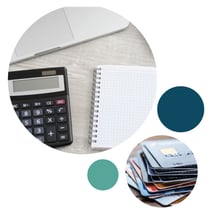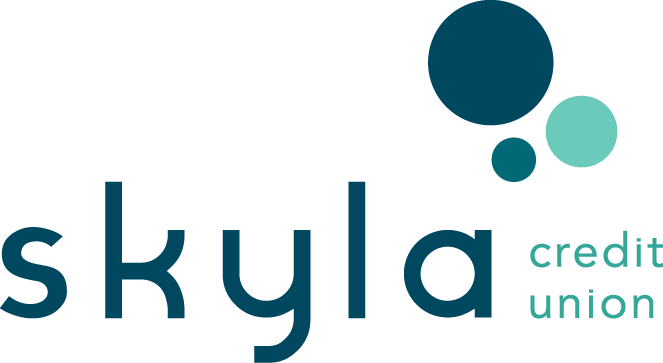What’s the Difference Between a Credit Card and a Line of Credit?

Have you ever been confused when your financial institution offered you a line of credit and not a credit card? When I was first introduced to financial products, the product I was very familiar with was credit cards since many people had them. But when I was offered a line of credit from my credit union, my immediate response was “Huh? I thought my credit card was a line of credit?!”

I knew I could use my credit card to pay for things as I need them, withdraw funds from my card if needed, and was earning cool rewards and other perks with the card, so I didn’t understand the benefits (or the difference) of a line of credit.
The first time I understood how a line of credit worked was when it came in handy at my cousin's wedding nearly six years ago. The venue cost $21,000 and credit cards were not accepted as a form of payment. Luckily, my aunt had a line of credit account with her bank and she was able to write a nice check for the full amount. Go, Aunt Viv!
In the example with my aunt Viv, the huge difference between a line of credit account and a credit card is that lines of credit accounts often give you access to a larger credit limit than credit cards and gave her immediate access to the cash without the vendor worrying about her card getting declined.
In this article, I’ll cover more differences and similarities, so you have a better idea of which kind of loan would work best for you. Ready?
here's a quick look at what we’ll cover
|
|
 what is a credit card?
what is a credit card?
A credit card is basically a revolving loan in card form. A lender issues you a line of credit up to a certain amount (your limit), and you can spend however much of it you’d like, pay it back, and spend the amount again. When repaying the lender, you may incur additional fees (like annual fees, cash advance fees, or balance transfer fees) and pay interest. Plus, there isn’t a set term, so you can keep your credit card account open indefinitely - as long as you stay in good standing with the lender.
QUICK TIP: Pay off your account balance and don’t miss a payment to keep your credit card account in good standing. |
Psst… when making a payment on a credit card, the lender usually allows you a grace period between 21-30 days after the close of the billing cycle to repay the money used without interest. After the grace period, you’ll start accruing interest charges unless you have a credit card that offers a 0% interest rate.
There are two credit card types - secured and unsecured. As explained in a recent article “Secured vs. Unsecured Credit Cards: What's the Difference?", an unsecured credit card is the most common type of credit card and does not require any collateral like cash to open/get approved. The lender only has your word that you’ll repay what you charge to the credit card and/or the fees and interest that accrue.
Opposite of that is a secured credit card, which is where you make a security deposit with cash to open the credit card account. The lender holds on to that deposit so you’re less of a risk to the lender should you default on a payment.
You can learn the differences between a secured and unsecured card, and when’s the right time to apply for either here:
The pros and cons of a credit card include:
pros
- Interest rates on credit cards are lower than lines of credit depending on your credit score and history.
- Using your credit card responsibly can build your credit score.
- If you're late making your monthly payment, many lenders allow you to pay within a grace period before you're hit with a late fee.
- It's so convenient to use. Just swipe your card to make the purchase and that's it!
- Depending on the credit card, you could earn rewards and cash back based on your purchases.
cons
- Paying interest on top of the principal balance.
- Lower loan limit than a line of credit.
- You can easily overspend if you don't have a budget in place.
 what is a line of credit?
what is a line of credit?
Similar to a credit card, a line of credit is revolving credit an individual or a business could obtain from a lender and use the money on demand. The key difference is you’ll typically receive a lower rate on a Line of Credit over a credit card, and your credit limit is often higher.
Plus, once you pay back the amount you’ve used, you can continually access that same credit limit as long as you stay in good standing. Additionally, you’ll only have to pay interest on the balance you use, so unlike a Personal Loan where you immediately begin paying back the loan in full with interest, you’re only paying for what you used.
One type of line of credit you may be familiar with is a home equity lines of credit (HELOC). This line of credit is exclusively for repairs and costs for a home and uses the equity you’ve built in your home to determine the credit limit. The cool thing with HELOC is if you needed to do a big repair like a bathroom renovation, you could get a big loan amount with a favorable interest rate compared to credit cards. Psst… your interest rate depends largely on your credit score and report. With HELOCs, you have flexibility in how you use the funds. You can pay a contractor a huge sum like $25,000 or whatever you choose according to your credit limit.
Since a line of credit can be secured and unsecured like a credit card, you'll find
- Secured lines of credit: This is a loan where you could receive a lower interest rate, but you'll need to put up collateral in order to get the loan. The lender will be able to give you a lower rate since you put up collateral. They could take the collateral from you if you fail or default on the loan. In this case, a HELOC would be a secured line of credit. The equity in your home would be the collateral which means the bank can take that from you if you default on your loan.
- Unsecured lines of credit: This type of LOC does not require collateral; you'll find this line of credit comes with higher interest rates compared to secured lines of credit.
The pros and cons of a line of credit include:
pros
- Getting a larger loan amount in terms of what you can access compared to credit cards.
- Having more flexibility in how you use the money.
- LOCs generally have lower interest rates compared to credit cards.
cons
- If you access your LOC, you’ll have to pay interest immediately.
- Rare chances of having rewards and perks like credit cards.
- There is no grace period. So as soon as you use the funds in the account, you'll have to pay it back when it's due.
QUICK TIP: When accessing your line of credit, the money is deposited into your account as opposed to a credit card where you make a purchase with a card and you eventually pay the lender back. |
The best way to get approved for a LOC is by having a relationship with your financial institution. Since the financial institution will be taking money and placing it in your account, you should have an existing account set up.
 how does a credit card vs. line of credit affect my credit score?
how does a credit card vs. line of credit affect my credit score?
Like any loan, both a credit card and a line of credit can affect your credit score. Just by officially applying for the loan, you're giving the lender consent to look into your financial background and pull your credit score. This would be a hard inquiry, which shaves a couple of points off your credit.
Credit is essential in the financial world - if you want to open a credit card, get a line of credit, buy a house or a car, get home or car insurance, or even get a new cell phone, your credit is going to be evaluated. Your credit score gives lenders an idea of how you handle money and base things such as the interest rate you pay on how your score looks. Here's a closer look at how a loan can affect your credit.
Another way both a credit card and a line of credit affect your credit score is if you fail to pay off your balance and when you fail to make your payments on time. Here are some specific actions that will hurt your credit score.
- Missing Payments: This affects your credit score by 60-100 points.
- Shopping for Credit Excessively: Plan for no more than 2-4 inquiries per year.
- Reaching the Limit on Credit Cards: You lose approximately 1 point for every % used on your credit card limit.

 is it better to use a line of credit or a credit card?
is it better to use a line of credit or a credit card?
This depends on what you need the funds for! If you're looking to make a small purchase or purchases over time, then a credit card would be best. Based on the credit card, you could earn reward points for making those purchases.
If you're looking to have a large sum of money readily available in your account in case you'll need to pay for a wedding, a home repair, or just need a flow of physical cash, then a line of credit account may be best. Psst… don't expect to get rewards from your lender when you have a line of credit account.
Interest rates on a LOC are typically lower than on credit cards but getting a low rate truly depends on your credit history. If you have a credit score that needs work, your interest rate might be as high as a credit card. If you're looking to improve your credit score, use these tips right away so you can start the process of improving your history and score.
here's what’s next
Whether you're using a credit card or have a lump sum of cash sitting in your account, the greatest downfall is being tempted to spend more than you should borrow. Even though the financial institution is lending you the funds to use, make sure you have a way of paying the funds back. Keep your utilization ratio low - the less you spend the better it looks on your credit report. You should always try to keep your utilization under 30%.
Did you know Skyla offers lines of credit and credit cards? Check it out!
As the Content Specialist and author of the Learning & Guidance Center, Yanna enjoys motivating others by uncovering all that's possible in the world of finance. From financial tips and tricks to ultimate guides and comparison charts, she is obsessed with finding ways to help readers excel in their journey towards financial freedom.
more resources for your credit card journey
Secured vs. Unsecured Credit Cards: What’s the Difference?
Knowing the difference between secured and unsecured credit cards could help you decide which is best for your financial needs. Here's what you should know.
10 min. read
What's the Most Important Thing to Understand About Credit Scores?
Need help understanding your credit score? Here’s what’s most important about credit scoring and the steps to take to improve it.
9 min. read
 Debit vs Credit Cards
Debit vs Credit Cards
Don't know the difference? Here's what you need to know to make an informed decision.
 Credit Cards vs. Lines of Credit
Credit Cards vs. Lines of Credit
Confused between the two? Here's a closer look at the difference.
 Secured vs Unsecured Credit Cards
Secured vs Unsecured Credit Cards
Knowing the difference could help you decide which is best for your financial needs. Here's what you should know.





.png)